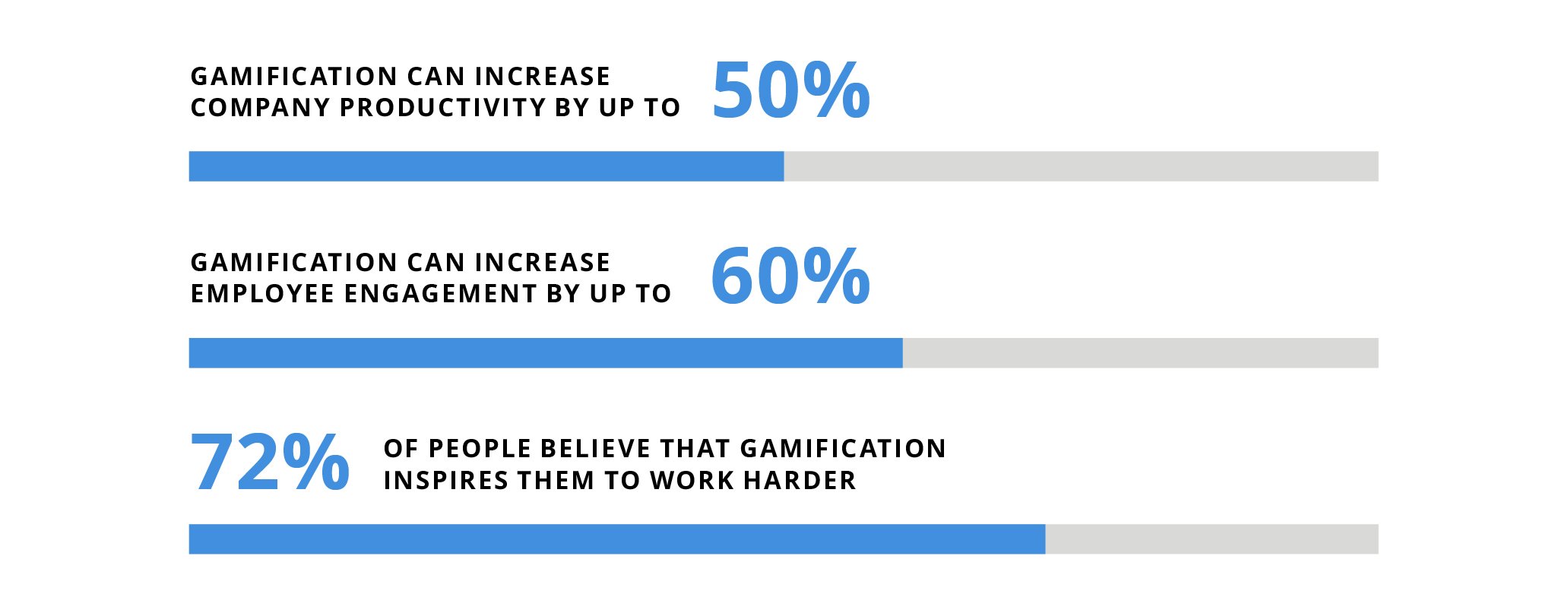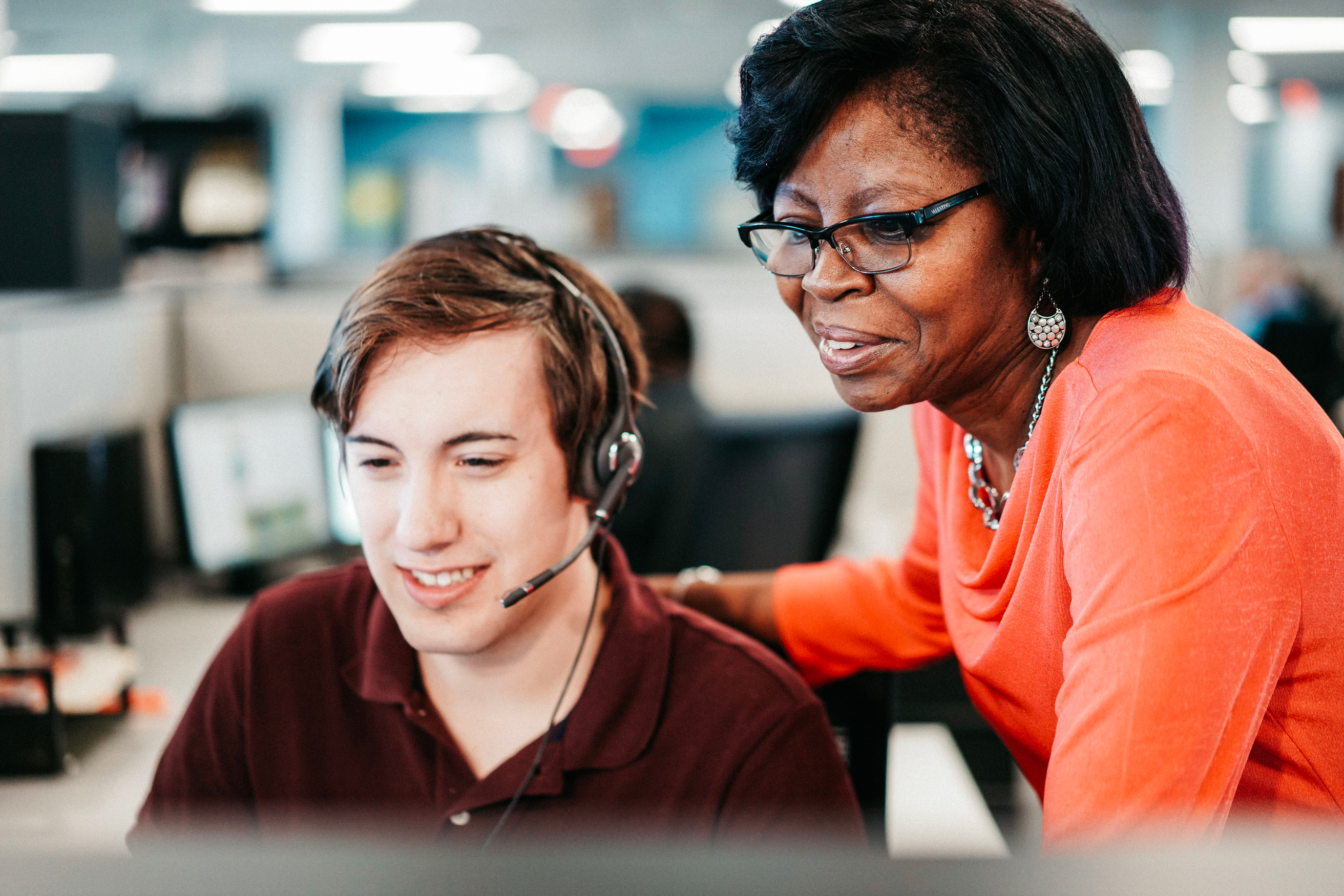Gamification: Leveling Up the Employee Experience
Why is more than half of the nation’s workforce quietly quitting?1
According to Gallup’s State of the Global Workplace: 2023 Report, 41% of quiet quitters are looking for a change in culture or level of engagement in the workplace. Many respondents in the Gallup Report went on to say they would like more recognition, more opportunities to learn and clearer goals.
Can workplace gamification check all the boxes?
This article discusses why gamification is an important influence in the employee experience, how to effectively implement a gamification program, and how technology has streamlined this process for both businesses and their employees.

1-UP: USING GAMIFICATION TO IMPROVE THE EMPLOYEE EXPERIENCE
Gamification has emerged as a transformative strategy in the workplace, enhancing the employee experience by incorporating game design elements into non-game contexts.
According to Salesforce, gamification fosters a fun, engaging and productive workplace.2
Effective uses for gamification in the workplace include training, coaching, and personal and professional goal achievement. It has been increasingly acknowledged as a tool for achieving motivational and behavioral goals for individuals and teams. Let’s look at why.
Promotes Engagement
Gamification is a powerful tool for enhancing employee engagement by cultivating a sense of community and a more stimulating and interactive work environment. Engaged employees have an overall higher well-being and lower rates of attrition and absenteeism.3
Improves Productivity
Gamification can significantly improve productivity in contact centers by encouraging a healthy level of competition and providing a sense of achievement. When employees receive rewards or recognition for task completion, they are motivated to continue, resulting in improved efficiency and output.4
 Fosters Empowerment
Fosters Empowerment
Gamification encourages employees to be accountable for their own tasks, career goals and successes.
It fosters a workplace atmosphere that promotes learning new skills and adopting positive behaviors.
Creates a Positive Work Environment
When implemented correctly, gamification can promote friendly rivalry among colleagues, creating a dynamic and engaging atmosphere that boosts both team cohesion and individual job fulfillment.5
MORLEY EXPERIENCE:
Gamification is not new to Morley. In fact, we have been implementing gamification as a way to
promote engagement, goal achievement and a fun work environment long before it was mainstream in
the early 2000s.
After many years and reiterations, gamification is still an effective practice for promoting a positive and fun
employee experience. You could say it is imprinted in our cultural DNA. Here are what a couple of our team
leads have to say.
“The gamification elements have significantly increased engagement among the team. Seeing real-time progress and competing in friendly challenges has boosted participation rates.”
“The leaderboards and team challenges have fostered a sense of teamwork and healthy competition within the department. It’s great to see team members encouraging and supporting each other to achieve goals.”
Insight #1: Gamification can lead to a workplace culture where agents are happier, more engaged and more productive, leading to reduced turnover.
THE CHEAT CODE FOR A SUCCESSFUL GAMIFICATION PROGRAM
With gamification proving to improve productivity, profitability and retention, it sounds like a no-brainer for any organization. It is easy to focus on company results, but it’s critical for a gamification program to be rooted in the employee’s experience to succeed.
Creating a successful game-based program requires a well-planned approach that aligns with your company’s objectives and actively involves employees.
Here are a few suggestions on how to create a successful gamification initiative:
- Understand your employees and what motivates them both extrinsically and intrinsically.
- Involve employees from different areas of the business in the process of planning and implementation.
- Communicate, communicate, communicate. Well-timed communication is important in the success of a program. It can also provide clarity and help promote engagement.
- Ensure that all participants understand:
- The objective of the program

- How the program works
- What the rules are
- What they can gain from participating
- The objective of the program
- Choose game elements that promote the behaviors you want to encourage, are tied to desired
outcomes and are valuable to the participants. - Rewards and recognition should be meaningful to those eligible to receive them. They can range from tangible items like gift cards to intangible rewards like recognition or professional development opportunities.
- Provide employees with real-time feedback on their participation.
- Continuously gather data and feedback to assess the effectiveness of the program and identify areas for improvement.
- Utilize this information to refine and enhance the program over time.
- Evaluate the program’s success against your initial objectives, including KPIs, CSAT and participation rates.
- Frequently and consistently celebrate achievements.
- Regularly introduce new challenges and rewards, encourage friendly competition, support peer-to-peer recognition and provide opportunities for employees to engage with the program.
Approximately 80% of workplace gamification initiatives fail.6 This lackluster result can often be attributed to inadequate planning, poor design and a lack of creativity. When implementing gamification strategies, it’s crucial to strive for well-thought-out and well-designed approaches that will truly enhance the employee experience.
MORLEY EXPERIENCE:
Each time Morley implements a new gamification initiative, the focus is decided based on an opportunity for improvement within our current performance, e.g., do we need to improve on a major KPI or expectation? It can be anything from improving attendance to exceeding client-set KPIs.
From there, team leads collaborate with employees to determine elements such as goals, theme,
mechanisms, duration and messaging. Leadership-led initiatives often feel forced and can miss the mark.
An employee-centric program, led from the start by the front line, can be a critical success factor. The importance of communication cannot be overstated. The type, content, frequency and method for
communication should be driven by employee input.
Insight #2: Aligning an employee-centric gamification program with company goals is the “Konami Code” of the business world.
POWERING UP YOUR GAMIFICATION PROGRAM WITH AUTOMATION
While highly effective, early adaptations of gamification programs took a lot of time and effort to coordinate. The process could be highly complex, time intensive and costly.
Like most business processes, gamification has evolved with the advancement of technology.

Numerous gamification software options are available for businesses to choose from in the marketplace. Gamification platforms can include progress management, achievement recognition, competition, collaboration and statistics.
Not yet convinced of the positive impact gamification can have on your organization? Gamification has become so popular in both workplace and educational settings that experts predict the international
gamification market will grow from $9.1 billion in 2020 to an estimated $30.7 billion by 2025.7
Some contact centers have a unique advantage in that they already have their own data collection processes and tools in place. Many are already using AI platforms such as Voice of the Customer or Automated Quality Management to automate the collection and analysis of data. This information can be used to determine areas of focus as well as an initiative’s success.
Successful contact centers, especially those that are remote or hybrid based, also have the technology
infrastructure in place to support collaboration, engagement and communication.
MORLEY EXPERIENCE:
Engagement in a contact center can be a difficult endeavor, particularly in a work-from-home or hybrid
environment. After the rapid shift from a brick-and-mortar environment to a remote environment post
COVID-19, engagement became an even higher priority. It is easier for agents working from home to become isolated and disengaged.
Where we once used public office spaces and in-person meetings, we now utilize graphic design software,
dashboards, email, and team collaboration software to digitally promote progress and recognition, and to
celebrate individual and team successes.
While our gamification program looks different than before, gamification and employee engagement are
stronger than ever because of our agile teams, leadership and technology. We believe humans make
technology better.
Insight #3: Automation, AI and other software can seamlessly integrate gamification into your business processes instead of adding to your teams’ workloads.
SUmmary
A well-planned, employee-centric gamification can improve productivity, profitability and retention in
your organization. Using increasingly advanced technology can help streamline processes for both your
business and its employees. If you’re worried about the investment, remember the “quietly quitting” statistic mentioned earlier and that the average cost of turning over a rep is $14,113.8
Sources:
- Gallup: State of the Global Workplace: 2023 Report
- Salesforce: 3 Ways Gamification Keeps Us Engaged and Motivated
- Gallup: Indicators – Employee Engagement
- Mambo: Gamification in the Workplace: Key to Engagement & Productivity
- Growth Tactics: The Power of Gamification in the Workplace: Boosting Performance
- Zippia: 25 Gamification Statistics [2023]: Facts + Trends You Need To Know
- Ibid.
- Gartner: Reduce Call Center Attrition

 By
By



